12 Plant Kingdom
By the end of this chapter you will be able to:
- Describe the major characteristics of members of the plant kingdom
- Discuss the challenges to plant life on land
- Describe the adaptations that allowed plants to colonize land
- Explain how plants sexually reproduce through alternation of generations
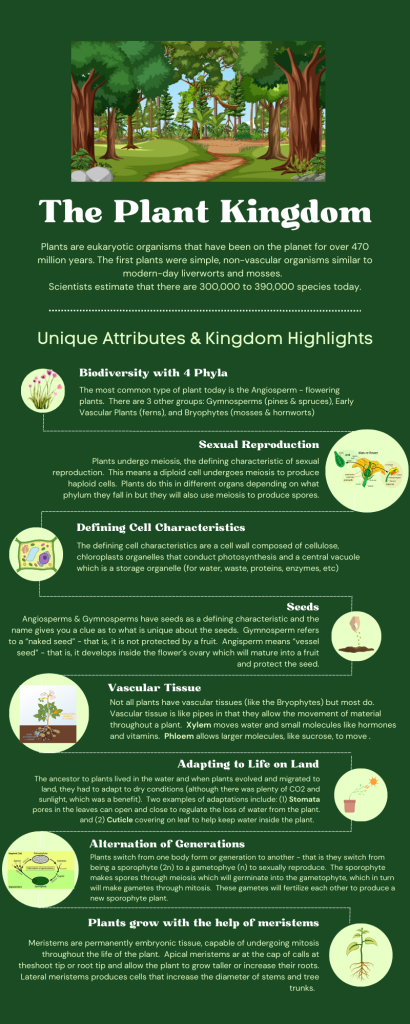
Introduction
Plants are a large and varied group of organisms (Fig 1). There are close to 300,000 species of cataloged plants. Of these, about 260,000 are plants that produce seeds. Mosses, ferns, conifers, and flowering plants are all members of the plant kingdom. The plant kingdom contains mostly photosynthetic organisms; a few parasitic forms have lost the ability to photosynthesize. The process of photosynthesis uses chlorophyll, which is located in organelles called chloroplasts. Plants possess cell walls containing cellulose. Most plants reproduce sexually, but they also have diverse methods of asexual reproduction. Plants exhibit indeterminate growth, meaning they do not have a final body form, but continue to grow body mass until they die.
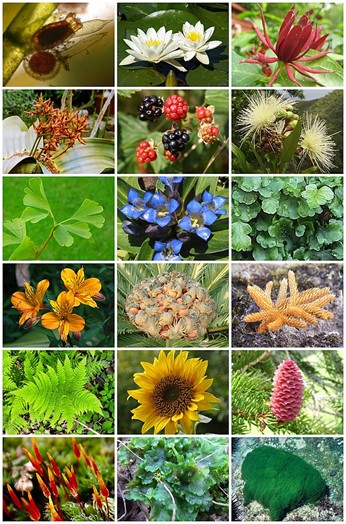
Figure 1: A representation of the different types of plants found today. Many produce flowers, plants called Angiosperms, which will give rise to fruits such as berries and nuts. Other plants are more primitive, the mosses and ferns. Termininja, via Wikimedia Commons
There are four major groups of plants, the most common today is the Angiosperm group, or those plants that make flowers at some point in their lives. Some angiosperms will produce flowers annually, typically in the spring or summer. Some angiosperms may only produce one flower in their lifetime before dying. An example of this is the agave plant, sometimes called the “century plant” because they bloom only once in their lifetime (Fig 2).

Figure 2: The agave plant. During sexual reproduction, the branches of the stalk are covered with masses of yellow flowers. After this time, the “mother” plant will die with the stalk falling and the offspring being dispersed. Puchku, via Wikimedia Commons
In general, land plants are classified into two major groups according to the absence or presence of vascular tissue, that is xylem and phloem for transporting water, nutrients, and food around the plant (Fig 3). Plants that lack vascular tissue formed of specialized cells for the transport of water and nutrients are referred to as nonvascular plants. The bryophytes, liverworts, mosses, and hornworts are seedless and nonvascular and likely appeared early in land plant evolution. Vascular plants developed a network of cells that conduct water and solutes through the plant body. The first vascular plants appeared in the late Ordovician (461–444 million years ago) and were probably similar to lycophytes, which include club mosses (not to be confused with the mosses) and the pterophytes (ferns, horsetails, and whisk ferns). Lycophytes and pterophytes are referred to as seedless vascular plants. They do not produce seeds, which are embryos with their stored food reserves protected by a hard casing. The seed plants form the largest group of all existing plants and, hence, dominate the landscape. Seed plants include gymnosperms, most notably conifers, which produce “naked seeds,” and the most successful plants, the flowering plants, or angiosperms, which protect their seeds inside chambers at the center of a flower. The walls of these chambers later develop into fruits.
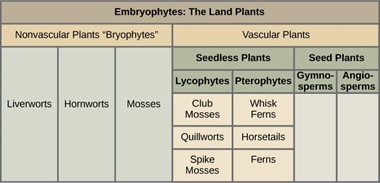
Figure 3: The major divisions of plants.
Adaptation to Life on Land
As organisms adapt to life on land, they have to contend with several challenges in the terrestrial environment. Water has been described as “the stuff of life.” The cell’s interior—the medium in which most small molecules dissolve and diffuse, and in which the majority of the chemical reactions of metabolism take place—is a watery soup. Desiccation, or drying out, is a constant danger for an organism exposed to air. Even when parts of a plant are close to a source of water, their aerial structures are likely to dry out. Water provides buoyancy to organisms that live in aquatic habitats. On land, plants need to develop structural support in air—a medium that does not give the same lift.
Additionally, the male gametes must reach the female gametes using new strategies because swimming is no longer possible. Finally, both gametes and zygotes must be protected from drying out. The successful land plants evolved strategies to deal with all of these challenges, although not all adaptations appeared at once. Some species did not move far from an aquatic environment, whereas others left the water and went on to conquer the driest environments on Earth.
To balance these survival challenges, life on land offers several advantages. First, sunlight is abundant. On land, the spectral quality of light absorbed by the photosynthetic pigment, chlorophyll, is not filtered out by water or competing photosynthetic species in the water column above. Second, carbon dioxide is more readily available because its concentration is higher in air than in water. Additionally, land plants evolved before land animals; therefore, until dry land was colonized by animals, no predators threatened the well-being of plants. This situation changed as animals emerged from the water and found abundant sources of nutrients in the established flora. In turn, plants evolved strategies to deter predation: from spines and thorns to toxic chemicals.
The early land plants, like the early land animals, did not live far from an abundant source of water and developed survival strategies to combat dryness. One of these strategies is drought tolerance. Mosses, for example, can dry out to a brown and brittle mat, but as soon as rain makes water available, mosses will soak it up and regain their healthy, green appearance. Another strategy is to colonize environments with high humidity where droughts are uncommon. Ferns, an early lineage of plants, thrive in damp and cool places, such as the understory of temperate forests. Later, plants moved away from aquatic environments using resistance to desiccation, rather than tolerance. These plants, like the cactus, minimize water loss to such an extent they can survive in the driest environments on Earth.
In addition to adaptations specific to life on land, land plants exhibit adaptations that were responsible for their diversity and predominance in terrestrial ecosystems. Four major adaptations are found in many terrestrial plants: the alternation of generations, a sporangium in which spores are formed, a gametangium that produces haploid cells, and in vascular plants, apical meristem tissue in roots and shoots.
Alternation of generations
The term “generation” can mean several things, but in the plant world, this term refers to what a plant physically looks like as well as whether the cells are diploid (2n) or haploid (n). Recall that diploid means there are two copies of DNA in a cell, whereas haploid means there is only one copy of DNA in the cell. The two generations are gametophyte, which is haploid, and the diploid sporophyte. As an example of a sporophyte, consider a fern plant (Fig 4). The plant you can see is sporophyte, each one of its cells would be diploid. The gametophyte generation you wouldn’t see. It is under the soil and looks more like a heart. This gametophyte is haploid.
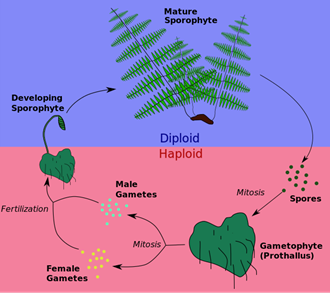
Figure 4: The fern life cycle. The adult fern we see growing is the sporophyte at the top of the image, whereas the gametophyte is in the soil and out of view. This diagram is not to scale. Jeffrey Finkelstein, via Wikimedia Commons
Alternation of generations describes a life cycle in which an organism has both haploid and diploid multicellular stages and it switches between these stages to sexually reproduce (Fig 5). Recall that sexual reproduction means that meiosis is occurring to reduce the ploidy of cells. That means that a diploid sporophyte must undergo meiosis to make haploid gametophytes.
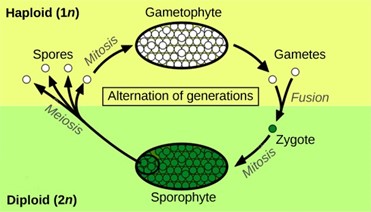
Figure 5: The alternation of generations between the haploid (1n) gametophyte and diploid (2n) sporophyte is shown. (credit: modification of work by Peter Coxhead)
Haplontic refers to a life cycle in which there is a dominant haploid stage. Diplontic refers to a life cycle in which the diploid stage is the dominant stage, and the haploid chromosome number is only seen for a brief time in the life cycle during sexual reproduction. Humans are diplontic, for example. Most plants exhibit an alternation of generations, which is described as haplodiplontic: the haploid multicellular form known as a gametophyte is followed in the development sequence by a multicellular diploid organism, the sporophyte. The gametophyte gives rise to the gametes, or reproductive cells, by mitosis.
It can be the most obvious phase of the life cycle of the plant, as in the mosses, or it can occur in a microscopic structure, such as a pollen grain in the higher plants (the collective term for the vascular plants). The sporophyte stage is barely noticeable in lower plants (the collective term for the plant groups of mosses, liverworts, and hornworts). Towering trees are the diplontic phase in the lifecycles of plants such as sequoias and pines.
Sporangia in the Seedless Plants
The sporophyte of seedless plants is diploid and results from syngamy or the fusion of two gametes (Fig 4). The sporophyte bears the sporangia (singular, sporangium), organs that first appeared in land plants. The term “sporangia” literally means “spore in a vessel,” as it is a reproductive sac that contains spores. Inside the multicellular sporangia, the diploid sporocytes, or mother cells, produce haploid spores by meiosis, which reduces the 2n chromosome number to 1n. The spores are later released by the sporangia and dispersed in the environment. Two different types of spores are produced in land plants, resulting in the separation of sexes at different points in the life cycle. Seedless nonvascular plants (more appropriately referred to as “seedless nonvascular plants with a dominant gametophyte phase”) produce only one kind of spore and are called homosporous. After germinating from a spore, the gametophyte produces both male and female gametangia, usually on the same individual. In contrast, heterosporous plants produce two morphologically different types of spores. The male spores are called microspores because of their smaller size; the comparatively larger megaspores will develop into the female gametophyte. Heterospory is observed in a few seedless vascular plants and all seed plants.
When the haploid spore germinates, it generates a multicellular gametophyte by mitosis. The gametophyte supports the zygote formed from the fusion of gametes and the resulting young sporophyte or vegetative form, and the cycle begins anew (Fig 6).
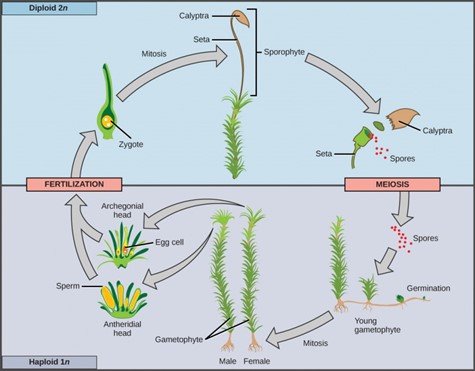
Figure 6: This life cycle of a moss shows alternation of generations with a dominant gametophyte stage. (credit: modification of work by Mariana Ruiz Villareal)
The spores of seedless plants and the pollen of seed plants are surrounded by thick cell walls containing a tough polymer known as sporopollenin. This substance is characterized by long chains of organic molecules related to fatty acids and carotenoids and gives most pollen its yellow color. Sporopollenin is unusually resistant to chemical and biological degradation. Its toughness explains the existence of well-preserved fossils of pollen. Sporopollenin was once thought to be an innovation of land plants; however, the green algae Coleochaetes is now known to form spores that contain sporopollenin.
Protection of the embryo is a major requirement for land plants. The vulnerable embryo must be sheltered from desiccation and other environmental hazards. In both seedless and seed plants, the female gametophyte provides nutrition, and in seed plants, the embryo is also protected as it develops into the new generation of sporophyte.
Gametangia in the Seedless Plants
Gametangia (singular, gametangium) are structures on the gametophytes of seedless plants in which gametes are produced by mitosis. The male gametangium, the antheridium, releases sperm. Many seedless plants produce sperm equipped with flagella that enable them to swim in a moist environment to the archegonia, the female gametangium. The embryo develops inside the archegonium as the sporophyte.
Apical Meristems
The shoots and roots of plants increase in length through rapid cell division within a tissue called the apical meristem (Fig 7). The apical meristem is a cap of cells at the shoot tip or root tip made of undifferentiated cells that continue to proliferate throughout the life of the plant. Meristematic cells give rise to all the specialized tissues of the plant. Elongation of the shoots and roots allows a plant to access additional space and resources: light in the case of the shoot, and water and minerals in the case of roots. A separate meristem called the lateral meristem, produces cells that increase the diameter of stems and tree trunks. Apical meristems are an adaptation to allow vascular plants to grow in directions essential to their survival: upward to greater availability of sunlight, and downward into the soil to obtain water and essential minerals.
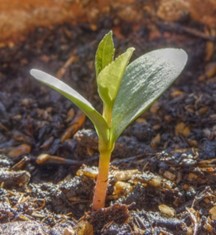
Figure 7: This apple seedling is an example of a plant in which the apical meristem gives rise to new shoots and root growth.
Additional Land Plant Adaptations
As plants adapted to dry land and became independent of the constant presence of water in damp habitats, new organs and structures made their appearance (Fig 8). Early land plants did not grow above a few inches off the ground, and on these low mats, they competed for light. By evolving a shoot and growing taller, individual plants captured more light. Because air offers substantially less support than water, land plants incorporate more rigid molecules in their stems (and later, tree trunks). The evolution of vascular tissue for the distribution of water and solutes was a necessary prerequisite for plants to evolve larger bodies. The vascular system contains xylem and phloem tissues. Xylem conducts water and minerals taken from the soil up to the shoot; phloem transports food derived from photosynthesis throughout the entire plant. The root system that evolved to take up water and minerals also anchored the increasingly taller shoot in the soil.

Figure 8: Plants have evolved various adaptations to life on land. (a) Early plants grew close to the ground, like this moss, to avoid desiccation. (b) Later plants developed a waxy cuticle to prevent desiccation. (c) To grow taller, like these maple trees, plants had to evolve new structural chemicals to strengthen their stems and vascular systems to transport water and minerals from the soil and nutrients from the leaves. (d) Plants developed physical and chemical defenses to avoid being eaten by animals. (credit a, b: modification of work by Cory Zanker; credit c: modification of work by Christine Cimala; credit d: modification of work by Jo Naylor)
In land plants, a waxy, waterproof cover called a cuticle coats the aerial parts of the plant: leaves and stems. The cuticle also prevents the intake of carbon dioxide needed for the synthesis of carbohydrates through photosynthesis. Stomata, or pores, that open and close to regulate the traffic of gases and water vapor, therefore, appeared in plants as they moved into drier habitats.
Plants cannot avoid predatory animals. Instead, they synthesize a large range of poisonous secondary metabolites: complex organic molecules such as alkaloids, whose noxious smells and unpleasant taste deter animals. These toxic compounds can cause severe diseases and even death.
Additionally, as plants coevolved with animals, sweet and nutritious metabolites were developed to lure animals into providing valuable assistance in dispersing pollen grains, fruit, or seeds. Plants have been coevolving with animal associates for hundreds of millions of years.
The following video is a little longer than other clips in this textbook, but it does a great job giving you an overall summary of non-vascular and vascular plants.
Summary
The Plant Kingdom is composed of a diverse and complex group of organisms that includes a wide range of multicellular, photosynthetic eukaryotes. Plants play a fundamental role in shaping Earth’s ecosystems, providing oxygen, food, and habitat for numerous organisms.
1. Evolution and Diversity: Plants evolved from aquatic ancestors and gradually adapted to life on land. They exhibit a remarkable diversity of forms, sizes, and habitats, ranging from microscopic algae to towering trees. The plant kingdom is traditionally classified into several major groups, including bryophytes (mosses, liverworts, hornworts), seedless vascular plants (ferns, clubmosses, horsetails), gymnosperms (conifers, cycads, ginkgos), and angiosperms (flowering plants).
2. Photosynthesis and Adaptations: One defining characteristic of plants is their ability to photosynthesize, utilizing sunlight, carbon dioxide, and water to produce energy-rich sugars and oxygen. This process is carried out by chloroplasts, which contain the pigment chlorophyll. Plants have evolved various adaptations to thrive in different environments, such as waxy cuticles to reduce water loss, vascular tissues for efficient nutrient transport, and diverse reproductive strategies.
3. Life Cycle and Alternation of Generations: Plants typically have a life cycle with alternation of generations, alternating between a multicellular haploid gametophyte phase and a multicellular diploid sporophyte phase. The gametophyte produces gametes (sperm and eggs), which fuse during fertilization to form a diploid zygote. This zygote develops into a sporophyte, which produces spores through meiosis. These spores give rise to new gametophytes, completing the cycle.
4. Reproduction: Plant reproduction varies across different groups. Bryophytes and some seedless vascular plants rely on water for fertilization, while gymnosperms and angiosperms have evolved pollen and seeds as reproductive structures. Angiosperms, the most diverse group of plants, have further developed flowers and fruits to attract pollinators and aid in seed dispersal.
5. Ecological Importance: Plants are crucial components of ecosystems. They provide primary production through photosynthesis, forming the base of food chains. Plants contribute to soil formation, prevent erosion, regulate the water cycle, and produce oxygen essential for animal respiration. They also support biodiversity by providing habitats and resources for various organisms.
6. Human Uses: Plants have immense economic, cultural, and medicinal significance for humans. They provide food crops (grains, fruits, vegetables), fiber (cotton, flax), building materials (wood), medicines (aspirin, digitalis), and industrial products (biofuels, dyes). Horticulture and agriculture are focused on cultivating and improving plant species to meet human needs.
The plant kingdom encompasses a wide array of organisms that have evolved diverse adaptations to colonize and thrive in terrestrial environments. From the smallest algae to the tallest trees, plants are essential contributors to the health and balance of Earth’s ecosystems and play a vital role in supporting life on our planet.
Questions
Glossary
References
Utah State University, 2023. Biology and the Citizen.

